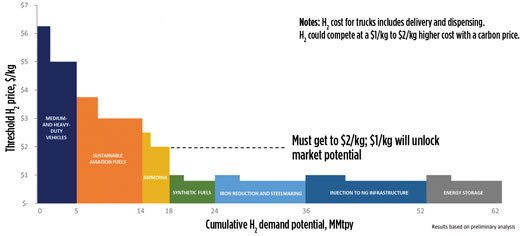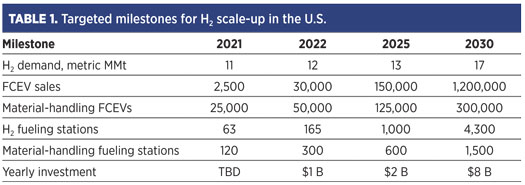The industry report, “Roadmap to a U.S. hydrogen economy,” released in October 2020, details how the U.S. can expand its global energy leadership by scaling up activity in the rapidly evolving H2 economy. The U.S. already produces approximately 11.4 metric MMtpy of H2—mostly in Texas, California and Louisiana—with an estimated value of about $17.6 B.
The vast majority of the U.S.’ existing production is “gray” H2 associated with CO2 emissions. However, with a combination of CCS projects to make gray H2 installations produce low-emissions “blue” H2, and a growing number of green H2 production projects powered by renewable energy, the Roadmap anticipates that H2 from low-carbon sources could supply roughly 14% of the country’s energy needs by 2050.
Green H2 projects will get off the ground more quickly, and at larger scale, as the cost of such projects decreases. One of the goals of the current U.S. administration is to reduce the cost of low-carbon H2 production, delivery and dispensing to $2/kg by 2025 and to $1/kg by 2030 (FIG. 1). At present, green H2 in the U.S. has a price point of around $5/kg, while blue H2 costs less than $2/kg, making blue H2projects more economical.
Infrastructure buildout is also needed to expand the use of low-carbon H2. The transportation sector will benefit from H2 infusion for long-haul trucks that require fast refueling, while the materials-handling sector is seeing growth in H2 fueling for FCEVs.
Reaching the Roadmap’s targets could drive around $140 B/yr in revenue by 2030, and approximately $750 B/yr in revenue by 2050. With sufficient near-term investment, the U.S. market for H2 across all segments could total 12 metric MMt at the end of 2022, 13 metric MMt at the end of 2025 and 17 metric MMt at the end of 2030, compared to around 11 metric MMtpy in late 2020 (TABLE 1).

Fig. 1. Market potential for H2 use in U.S. based on cost. Source: U.S. Department of Energy, Office of Energy Efficiency and Renewable Energy, Hydrogen and Fuel Cell Technologies Office.
